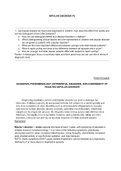BIPOLAR DISORDER P2
1. Can bipolar disease be found and diagnosed in children, how does this differ from adults and
can we distinguish it from other diseases?
a. How can we distinguish ADHD from Bipolar Disorder in children?
b. Which distinguishing clinical factors are over represented in children with bipolar disorder
as compared to patients with unipolar disorder?
c. What are the most important differences between younger and older bipolar patients?
d. What is rapid cycling and what is the difference between an episode and a cycle?
e. How do younger and older bipolar patients differ with respect to rapid cycling?
Pointer: In Marangoni focus on summary table and think about how we can use this in terms of
diagnostic tools.
Robert Kowatch
DIAGNOSIS, PHENOMENOLOGY, DIFFERENTIAL DIAGNOSIS, AND COMORBIDITY OF
PEDIATRIC BIPOLAR DISORDER
Remember
Bipolar I disorder – manic episode that lasts at least 1 week, with symptoms of elevated or
irritable mood or increased energy + 3 or more of the following symptoms: grandiosity,
decreased need for sleep, increased talkativeness, racing thoughts, distractibility, increased
goal-oriented activity or psychomotor agitation, and risky behavior.
NOTE: manic symptoms MUST cause marked impairment, can be followed by a hypomanic
(lasting for 4 or more days) or depressive episode
,Bipolar II – requires one or more hypomanic episode (for at least 4 days) and one or more
depressive episodes (for at least 2 weeks) w/o experiencing any manic episodes.
Cyclothymic disorder – chronic, fluctuating mood disturbance that lasts for a distinct period
(for at least 2 years for adults, 1 year for pediatric patients) or time, patients exhibit symptoms
of hypomania/depression/manic but never meet full criteria
Other specified bipolar and related disorder – given to pediatric patients who have bipolar
symptoms that do not meet the full criteria for any of the disorder in the bipolar class but that
CAUSE stress or impairment
● Phenomenology
The pediatric literature contains estimated that children with bipolar disorder may have
thousands of mood swings (cycles) per year
Cycle = a pronounced shift in mood and energy from one extreme to another
Episode = an extended period of mood dysregulation often encompassing multiple cycles in
polarity
Do NOT confuse the pediatric cycling with rapid cycling here, the number of DISTINCT episodes
still remain small in these patients.
Symptoms:
The following symptoms were found in more than 70% of pediatric participants:
- Increased energy
- Irritability
- Mood lability
- Distractibility
- Goal-directed activity
Pediatric patients spend more time experiencing symptoms overall (e.g. around 60% ot the time
in 4 years), especially depressive symptoms last longer (as it is in adults)
NOTE: often children under 13 will be diagnosed with ‘other specified bipolar and related
disorder’ due to lack of symptoms meeting criteria for an episode.
These younger patients will commonly exhibit irritability, mood lability, and a worse course of
illness than patients with a later onset
, ● Red flag symptoms and features
Most common ‘’red flag’’ symptoms in pediatric patients are: rage and aggression, experienced
several times a day for hours
+ Decreased need for sleep (due to a manic or hypomanic episode), which can last for a
several days
NOTE! This should not be confused with insomnia due other psychiatric and medical conditions
such as ADHD.
+ Spontaneous mood shifts that are out of context
NOTE: For adolescents – higher level of grandiosity
+ High risk behaviors, and actions not appropriate in the context
+ Family history of mood disorders, especially bipolar disorders (around 11% of children of
parents with bipolar had bipolar spectrum disorders)
+ Other risk factors or features that suggest bipolar disorder include early-onset
depression, psychotic features, and recurring episodes of depression.
● Screening tools
- The young mania rating scale – focuses more on the severity of symptoms
- Mood disorder questionnaire
- Child behavior checklist
- The child mania rating scale – completed by parents, can distinguish between mania vs
ADHD or no disorder quite well
● Differential diagnosis
Attention-deficit/hyperactivity disorder: defined as ‘’ a persistent pattern of inattention and
hyperactivity-impulsivity that interferes with functioning or development’’
How can we differentiate?
- Most manic symptoms significantly more prevalent in those with bipolar (although they
can still be seen in ADHD)
Features that are common in both that are NOT useful in differentiating are: irritability,
hyperactivity, accelerated speech, and distractibility
- For ADHD it those behaviors do not change that much, whereas in bipolar change in
mood and behavior is often displayed when an episode occurs (or cycles, less
consistent)
Oppositional defiant disorder: defined as ‘’ a pattern of angry and irritable mood, argumentative
and defiant behavior, or vindictiveness lasting at least 6 months'’.
How can we differentiate?
- ODD is not categorized by cycles – it is a chronic disorder





